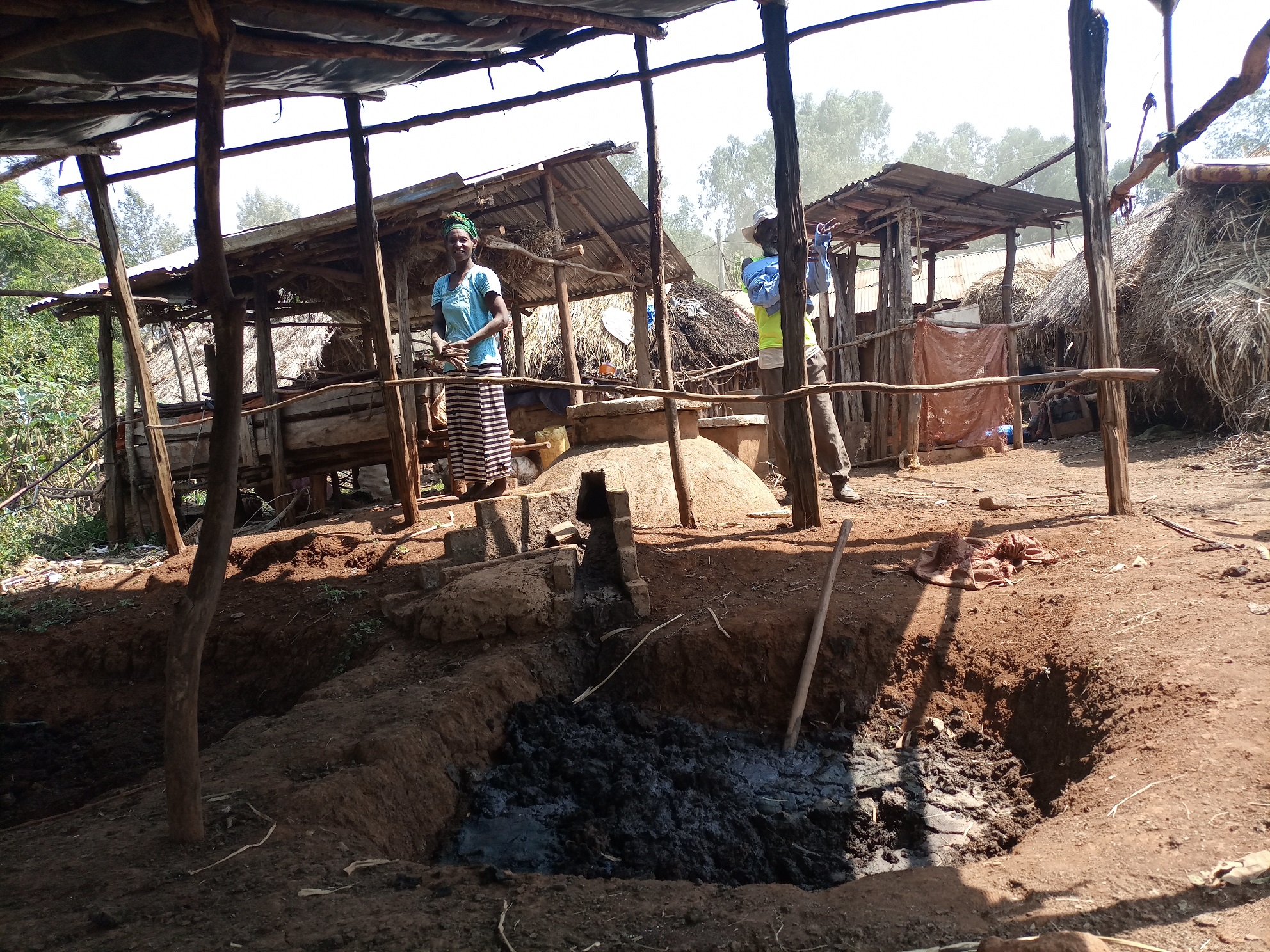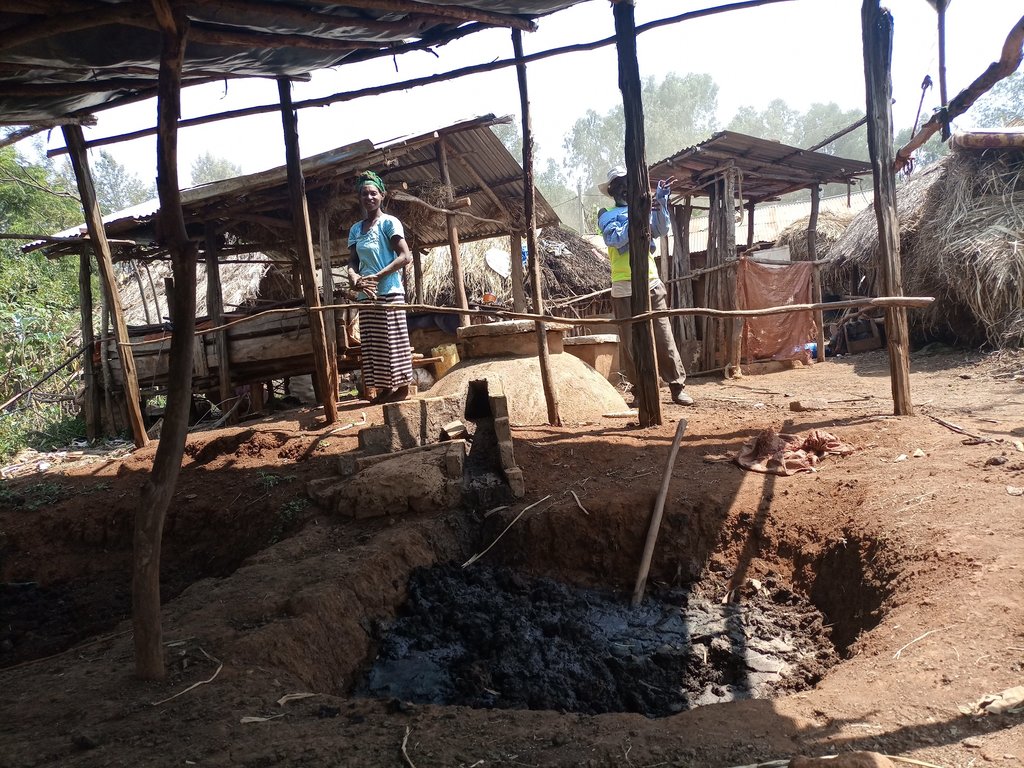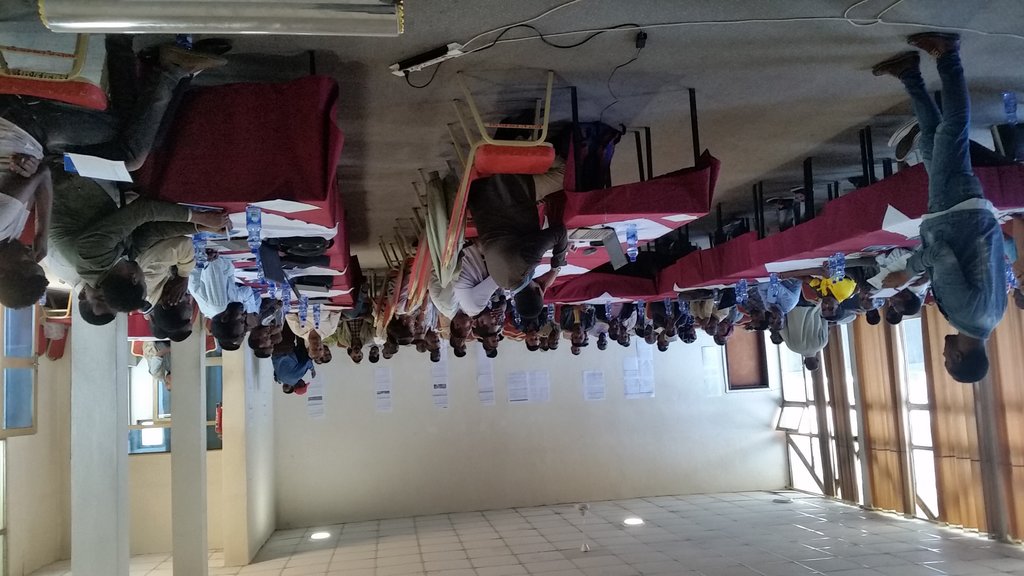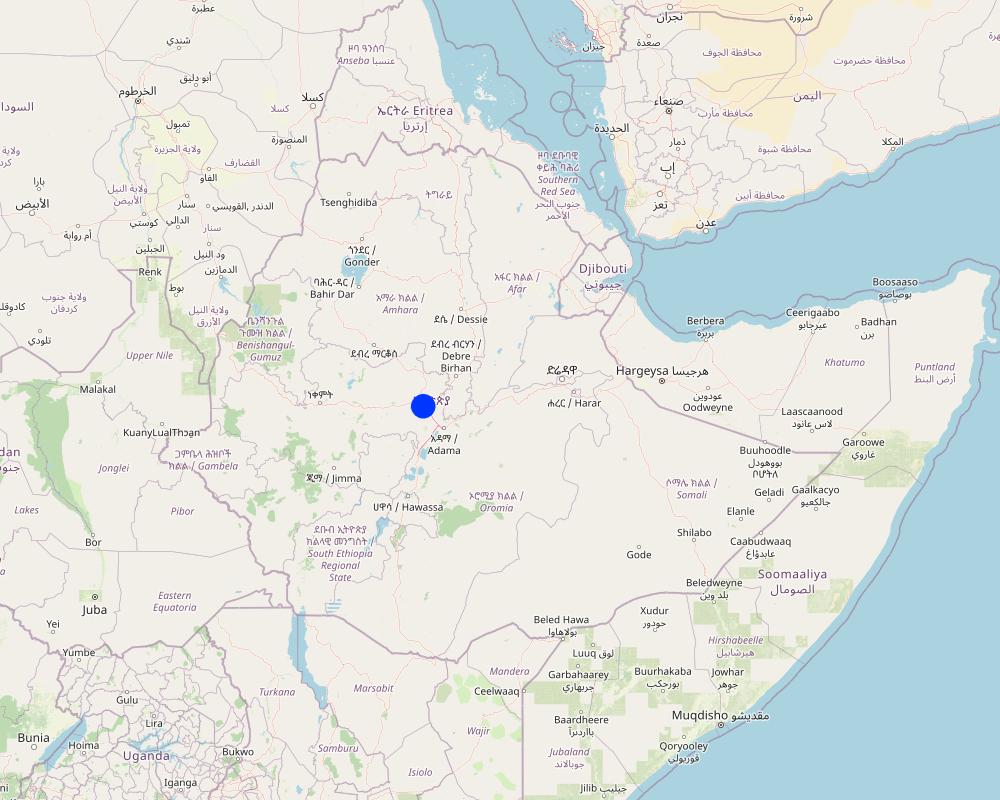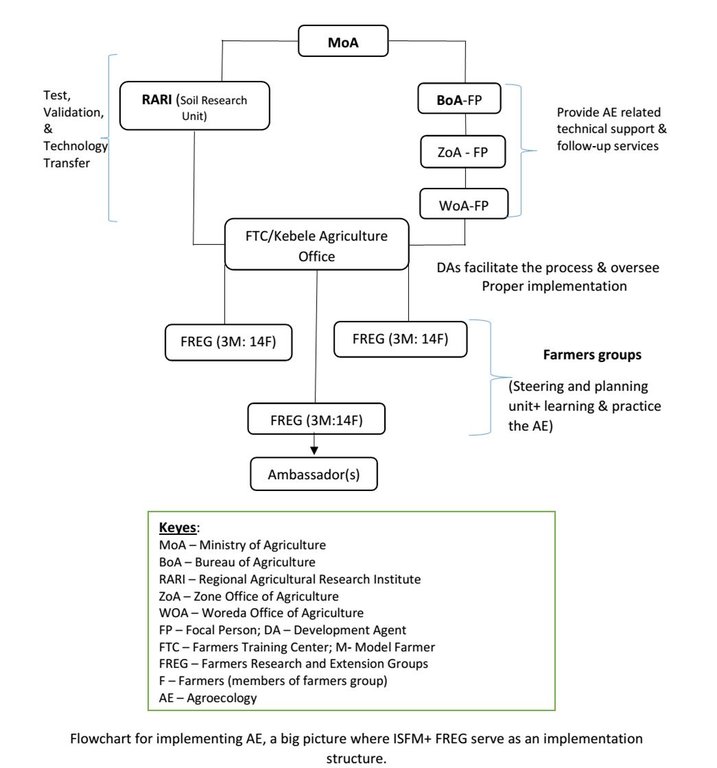Integrated Soil Fertility Management (ISFM) [ອີທິໂອເປຍ]
- ການສ້າງ:
- ປັບປູງ:
- ຜູ້ສັງລວມຂໍ້ມູນ: GERBA LETA
- ບັນນາທິການ: Noel Templer, Julia Doldt, Torben Helbig, Tabitha Nekesa, Ahmadou Gaye, Siagbé Golli
- ຜູ້ທົບທວນຄືນ: William Critchley, Rima Mekdaschi Studer, Sally Bunning
Qindoomina Misooma Gabbina Biyyee (Afaan Oromoo) /Yeteqenaje ye Afer Limat (Amharic)
approaches_6732 - ອີທິໂອເປຍ
ເບິ່ງພາກສ່ວນ
ຂະຫຍາຍທັງໝົດ ຍຸບທັງໝົດ1. ຂໍ້ມູນທົ່ວໄປ
1.2 ລາຍລະອຽດ ການຕິດຕໍ່ ຂອງບຸກຄົນທີ່ຊັບພະຍາກອນ ແລະ ສະຖາບັນ ການມີສ່ວນຮ່ວມ ໃນການປະເມີນຜົນ ແລະ ເອກະສານ ຂອງວິທີທາງ
ຊື່ຂອງໂຄງການ ທີ່ອໍານວຍຄວາມສະດວກ ໃນການສ້າງເອກກະສານ ຫຼື ປະເມີນດ້ານແນວທາງ (ຖ້າກ່ຽວຂ້ອງ)
Soil protection and rehabilitation for food security (ProSo(i)l)ຊື່ຂອງ ສະຖາບັນການຈັດຕັ້ງ ທີ່ອໍານວຍຄວາມສະດວກ ໃນການສ້າງເອກກະສານ ຫຼື ປະເມີນແນວທາງ (ຖ້າກ່ຽວຂ້ອງ)
Alliance Bioversity and International Center for Tropical Agriculture (Alliance Bioversity-CIAT) - ເຄັນຢາ1.3 ເງື່ອນໄຂ ຂອງການນໍາໃຊ້ເອກກະສານຂໍ້ມູນ ຂອງ WOCAT
ເມື່ອໃດທີ່ໄດ້ສັງລວມຂໍ້ມູນ (ຢູ່ພາກສະໜາມ)?
07/02/2023
ຜູ້ສັງລວມ ແລະ ບັນດາຜູ້ຕອບແບບສອບຖາມ ຍອມຮັບໃນເງື່ອນໄຂ ການນໍາໃຊ້ຂໍ້ມູນເອກະສານ ທີ່ສ້າງຂື້ນ ໂດຍຜ່ານ ອົງການ WOCAT:
ແມ່ນ
1.4 ເອກະສານອ້າງອີງ (ຫຼາຍ) ກັບແບບສອບຖາມ (ຫຼາຍ) ເຕັກໂນໂລຢີ ຂອງດ້ານການຄຸ້ມຄອງ ດິນແບບຍືນຍົງ
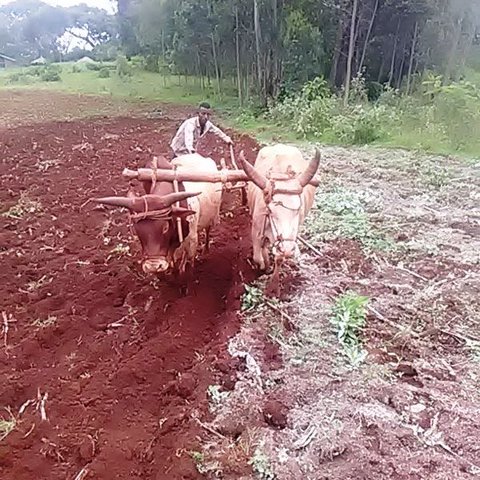
Treating acid soils with lime [ອີທິໂອເປຍ]
Acidic soils deprive crops of their full nutrient absorption capacity. Lime application to these soil makes them less acidic. It breaks the barrier that fixes nutrients and ensures crops access to vital soil nutrients that unleash their productivity potential.
- ຜູ້ສັງລວມຂໍ້ມູນ: GERBA LETA
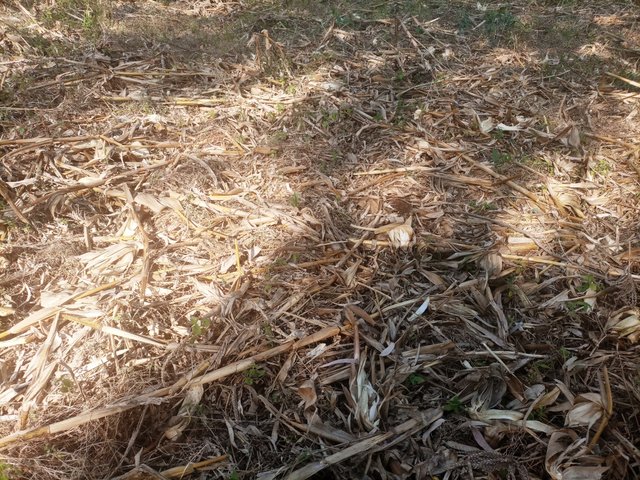
Crop Residue Management [ອີທິໂອເປຍ]
Crop residue management involves leaving stover and other trash from cereal crops (including tef, wheat and maize), as well as haulms of legumes, in the field. Crop residues keep the soil covered, retain organic matter and moisture in the soil, and help to ensure better production.
- ຜູ້ສັງລວມຂໍ້ມູນ: GERBA LETA
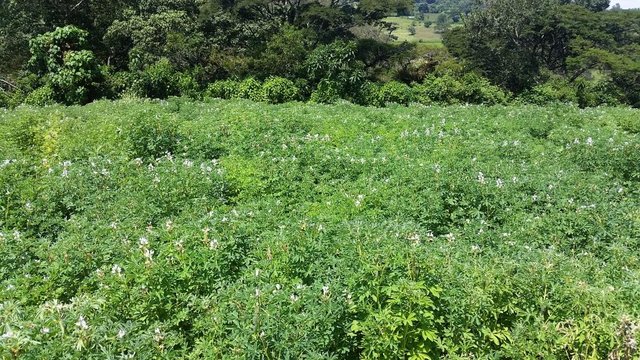
Green Manures [ອີທິໂອເປຍ]
Green manures are fast-growing legumes sown in a field, weeks or even months before the main crop is planted. These are plants that are deliberately grown for incorporation into the soil to improve fertility and organic matter content.
- ຜູ້ສັງລວມຂໍ້ມູນ: GERBA LETA
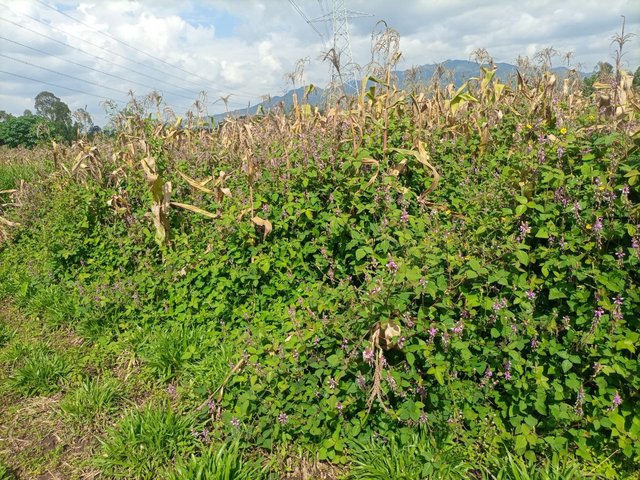
Cover crops [ອີທິໂອເປຍ]
Cover crops are crops grown on bare, fallow farmland or under a main crop to cover and conserve the soil by protecting it from exposure to the sun, wind, and direct impact of rain. It fixes nitrogen (if a legume), improves soil fertility, supplies livestock fodder, and helps manage both …
- ຜູ້ສັງລວມຂໍ້ມູນ: GERBA LETA

Relay Intercropping [ອີທິໂອເປຍ]
Intercropping is the growing of two or more crops on the same piece of land at the same time or in temporal sequence. Relay intercropping usually involves planting a legume into an established cereal crop. This farming practice has multiple benefits and is a popular among smallholders in Wolaita zone …
- ຜູ້ສັງລວມຂໍ້ມູນ: GERBA LETA
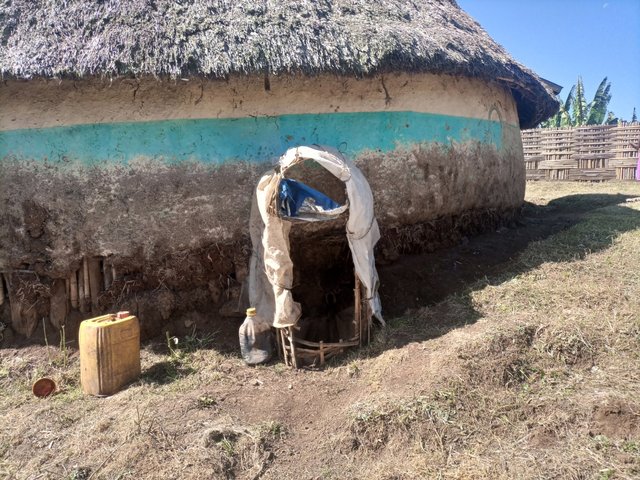
Livestock Urine Collection and Use [ອີທິໂອເປຍ]
Collection of livestock urine allows resource-poor farmers to capture nutrient-rich livestock waste and use it to substitute urea fertilizer. It is a liquid organic product that restores soil fertility and pest management.
- ຜູ້ສັງລວມຂໍ້ມູນ: GERBA LETA
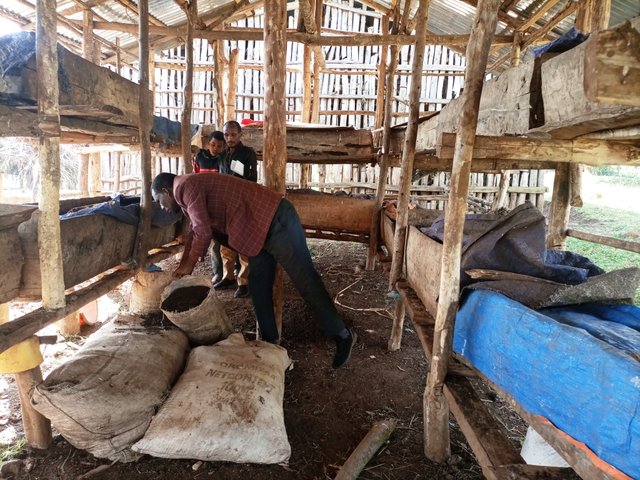
Vermicomposting [ອີທິໂອເປຍ]
Vermicompost is the product of the decomposition process using various species of earthworms. It is a form of humus and is produced through worms digesting and excreting organic in their casts. Vermicompost has been shown to be an effective organic soil amendment, reducing the need for inorganic fertilizers.
- ຜູ້ສັງລວມຂໍ້ມູນ: GERBA LETA
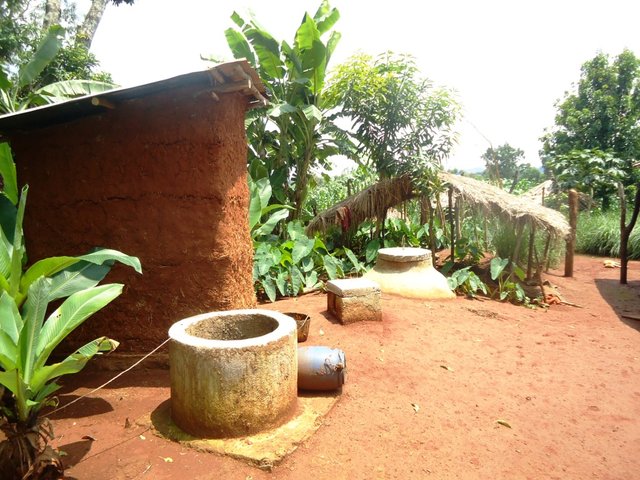
Bioslurry [ອີທິໂອເປຍ]
Bioslurry is a byproduct of the anaerobic process used for production of methane (biogas). It is derived from the manure used to feed the biodigester. Bioslurry is an organic fertilizer that serves as a replacement for chemical fertilizers, and also plays a pesticidal role.
- ຜູ້ສັງລວມຂໍ້ມູນ: GERBA LETA
2. ພັນລະນາ ແນວທາງການຄຸ້ມຄອງນໍາໃຊ້ດິນແບບຍືນຍົງ
2.1 ການອະທິບາຍ ໂດຍຫຍໍ້ ຂອງວິທີທາງ
The Integrated Soil Fertility Management (ISFM) approach has been adopted under the Integrated Soil Fertility Management Project (ISFM+). It was introduced as a quick-win solution to increase both crop and biomass production through the incremental promotion of varied but complementary technology packages.
2.2 ການອະທິບາຍ ລາຍລະອຽດ ຂອງວິທີທາງ
ການອະທິບາຍ ລາຍລະອຽດ ຂອງວິທີທາງ:
The Integrated Soil Fertility Management (ISFM) approach is intended to increase both crop and biomass production through the incremental promotion of varied but complementary technology packages. These include the production and use of organic fertilizers, treatment of soil acidity, and improved retention of crop residue. All help in reducing the depletion (mining) of soil nutrients. One characteristic feature is the engagement of research and development partners at all levels such as in joint problem identification, learning, participatory planning, piloting technology, and exchange visits. The approach involves model farmers and also focuses on farmers with limited means to purchase chemical fertilizers. It enhances the production of organic fertilizers to increase both soil fertility and crop productivity. Furthermore, ISFM enables farmers to generate off-farm and on-farm income through the production and sale of organic fertilizers, vermiworms, and green manure seeds, etc. The partners assist in identifying soil-related issues, as well as enhancing the adoption and institutionalization of the approach. ISFM aims to improve stakeholders' understanding of land degradation issues and the necessity of SLM by creating access to relevant seasonal training, exposure visits, collective learning, and action.
Project focal persons representing partners at different levels and development agents (DAs) are used to facilitate the process and serve as potential links with stakeholders. At the local level, the Farmers Research and Extension Group (FREG) sub-approach supports the implementation of the technologies on an incremental basis (see WOCAT database). Also, the Soil Fertility Improvement Cluster approach (see WOCAT database) assists in scaling out of the ISFM approach by adopting and superimposing technologies such as vermicompost with improved compost production. Farmer ambassadors are identified from the FREG model based on their performance. They assist in mainstreaming and dissemination of the approach and technologies to indirect beneficiaries. The implementation process of the ISFM involves district and kebele selection, identification of watersheds and voluntary farmers, provision of capacity-building training, conducting participatory planning, supplying inputs, and technical support. To realize the aims, the ISFM+ allocates financial support to the partners at different levels via Local Subsidy Contract.
Project staff including federal and regional advisors are involved. They provide training, technical backstopping, reviewing progress, M&E, and feedback services. District focal person closely follows up on the implementation - with the support of DAs in steering farmers' group meetings and collective learning. In addition, DAs assist in piloting on farm short and long-term demonstrations, organizing field days and exchange visits, collecting data, and overseeing activities.
Land users like the technologies introduced and implemented via the ISFM approach. The promotion of collective learning and action leads to increased soil fertility, and improved crop production and smallholders' livelihoods. The creation of new sources of income for land users is among the benefits they appreciate the most. However, farmers are less enthusiastic by the way that group meetings clash with their other activities and this leads to some members dropping out. Also, the cost of technologies promoted by the ISFM such as combined uses of chemical fertilizers, bio-fertilizers (for legumes), organic fertilizers, and quality seeds are envisaged as a possible constraint among others.
2.3 ຮູບພາບຂອງແນວທາງ
2.4 ວີດີໂອ ຂອງວິທີທາງ
ຄວາມຄິດເຫັນ, ຄໍາອະທິບາຍຫຍໍ້:
Video of the approach is not documented.
2.5 ປະເທດ / ເຂດ / ສະຖານທີ່ບ່ອນທີ່ແນວທາງໄດ້ຖືກນໍາໃຊ້
ປະເທດ:
ອີທິໂອເປຍ
ຂໍ້ມູນເພີ່ມເຕີມຂອງສະຖານທີ່:
Addis Ababa
ຄວາມຄິດເຫັນ:
The approach is currently applied in three to four regional states of Ethiopia.
Map
×2.6 ວັນທີເລີ່ມຕົ້ນ ແລະ ສິ້ນສຸດ ການຈັດຕັ້ງປະຕີບັດ ວິທີທາງ
ສະແດງປີຂອງການເລີ່ມຕົ້ນ:
2015
ຖ້າຫາກບໍ່ຮູ້ຈັກປີທີ່ແນ່ນອນ, ໃຫ້ປະມານຄາດຄະເນ ເອົາມື້ທີ່ໄດ້ເລີ່ມຈັດຕັ້ງປະຕິບັດ ວິທີທາງ:
ຕໍ່າກວ່າ 10 ປີ ຜ່ານມາ (ມາເຖິງປະຈຸບັນ)
ປີທີ່ສີ້ນສູດ (ຖ້າຢຸດບໍ່ໄດ້ນໍາໃຊ້ ວິທີທາງ):
2025
ຄວາມຄິດເຫັນ:
The project will be operational up to 2025.
2.7 ປະເພດຂອງແນວທາງ
- ພາຍໃຕ້ໂຄງການ / ແຜນງານ
2.8 ເປົ້າໝາຍ / ຈຸດປະສົງຫຼັກ ຂອງການຈັດຕັ້ງປະຕິບັດ ວິທີທາງ
The main objective of the approach is to promote the integration of technologies, collective learning, and action for treating degraded soil, increasing soil fertility and crop productivity while ensuring sustainable uses of land.
2.9 ເງື່ອນໄຂອໍານວຍ ຫຼື ຂັດຂວາງການປະຕິບັດຂອງເຕັກໂນໂລຢີ / ເຕັກໂນໂລຢີການນໍາໃຊ້ຕາມແນວທາງ
ມີຄວາມສາມາດ / ເຂັ້າເຖິງຊັບພະຍາກອນດ້ານການເງິນ ແລະ ການບໍລິການ
- ອໍານວຍ
Access to financial resources improved farmers' access to materials and inputs on their own. This promotes the adoption and scaling up of the technology using ISFM approach.
ການກໍ່ຕັ້ງສະຖາບັນ
- ອໍານວຍ
Institutional setting such as farmers' group formation promotes collective learning and action.
ການຮ່ວມມື / ການປະສານງານຂອງຜູ້ກ່ຽວຂ້ອງ
- ອໍານວຍ
Is central to promoting effective implementation of the approach that entails various research and development actors.
ນະໂຍບາຍ
- ອໍານວຍ
Such as adopting lime production, distribution and use policy enables successful implementation of the approach.
ຄວາມຮູ້ກ່ຽວກັບການຄຸ້ມຄອງ ທີ່ດິນແບບຍືນຍົງ, ການເຂົ້າເຖິງການສະໜັບສະໜູນ ທາງດ້ານວິຊາການ
- ອໍານວຍ
ຕະຫຼາດ (ໃນການຊື້ວັດຖຸດິບ, ຂາຍຜະລິດຕະພັນ) ແລະ ລາຄາ
- ອໍານວຍ
ວຽກ, ມີກໍາລັງຄົນ
- ອໍານວຍ
Family labor enables production of organic fertilizers and effective implementation of lime and other technologies which are labor intensive.
3. ການມີສ່ວນຮ່ວມ ແລະ ບົດບາດຂອງພາກສ່ວນທີ່ກ່ຽວຂ້ອງທີ່ໄດ້ມີສ່ວນຮ່ວມ
3.1 ຜູ້ມີສ່ວນຮ່ວມ ໃນວິທີທາງ ແລະ ພາລະບົດບາດ ຂອງເຂົາເຈົ້າ
- ຜູ້ນໍາໃຊ້ດິນໃນທ້ອງຖິ່ນ / ຊຸມຊົນທ້ອງຖິ່ນ
Model farmers, and other smallholders (followers).
Lead group meeting, facilitate collective learning and action based on the pilot practices/activities.
- ຜູ້ຊ່ຽວຊານ ການນຄຸ້ມຄອງ ທີ່ດິນແບບຍືນຍົງ / ທີ່ປຶກສາດ້ານກະສິກໍາ
Focal persons and experts from soil fertility improvement /extension unit of the district.
Facilitate implementation of the technology via the approach, and serve as a link between stakeholders.
- ນັກຄົ້ນຄວ້າ
Soil researchers from Regional Research Institutes, and respective technologies.
Soil testing, production of bio fertilizer, and supporting the different technologies with research findings.
- ອົງການຈັດຕັ້ງ ທີ່ບໍ່ຂື້ນກັບລັດຖະບານ
SNV Ethiopia, Nutrition Sensitive Agriculture, and other GIZ projects.
Integration of efforts such as on biogas/bioslurry production and other respective project implementation activities.
- ພາກເອກະຊົນ
Agro dealers, and other services providers
Facilitate the distribution of lime and improved seeds, provide services on mechanization such as maintenance, etc.
- ອໍານາດ ການປົກຄອງທ້ອງຖິ່ນ
District office of agriculture, and woreda administration.
Partnerships, acknowledge implementation of the project and provide administrative support when required.
- ພະນັກງານຂັ້ນສູນກາງ (ຜູ້ວາງແຜນ, ຜູ້ສ້າງນະໂຍບາຍ)
Ministry of Agriculture and Research System.
Support in mainstreaming the technology and approach, policy formulation and research support testing soil and tools...
- ອົງການຈັດຕັ້ງ ສາກົນ
CIAT, CIMMYT, ICRISAT...
Provide research and technical support in joint areas of intervention.
ຖ້າຫາກມີຫຼາຍພາກສ່ວນທີ່ເຂົ້າຮ່ວມ ໃຫ້ລະບຸ ອົງການທີ່ເປັນຫຼັກ ໃນການຈັດຕັ້ງປະຕິບັດ:
Integrated Soil Fertility Management Project (ISFM+).
3.2 ການມີສ່ວນຮ່ວມຂອງຜູ້ນໍາໃຊ້ທີ່ດິນໃນທ້ອງຖິ່ນ / ຊຸມຊົນທ້ອງຖິ່ນໃນໄລຍະທີ່ແຕກຕ່າງກັນຂອງແນວທາງ
| ການລວບລວມ ເອົາຜູ້ນໍາໃຊ້ດິນ ໃນທ້ອງຖິ່ນ / ຊຸມຊົນທ້ອງຖິ່ນ | ໃຫ້ລະບຸ ຜູ້ໃດທີ່ມີສ່ວນຮ່ວມ ໃນແຕ່ລະກິດຈະກໍາ? | |
|---|---|---|
| ການເລີ່ມຕົ້ນ / ແຮງຈູງໃຈ | ການຊ່ວຍເຫຼືອຈາກພາຍນອກ | District focal person and development agents. Facilitate the implementation right from awareness raising, farmers' group formation, training, supply inputs, and technically support the implementation. |
| ການວາງແຜນ | ການຮ່ວມມື | Regional advisor, focal persons, and the farmers. Each engaged in a participatory planning exercise. |
| ການປະຕິບັດ | ການຮ່ວມມື | Farmers, focal persons, and development agents. Farmers implement the technologies being guided by the approach. Whereas, the focal person and development agents oversee and provide technical support. |
| ຕິດຕາມກວດກາ / ການປະເມີນຜົນ | ການຮ່ວມມື | Focal person, development agents, and land users. They conduct participatory M&E to ensure collective learning. |
3.3 ແຜນວາດ (ຖ້າມີ)
ການອະທິບາຍ:
ISFM approach that run from the federal to kebele where FREG is the pillar approach serving the land users as a platform for collective learning and action at local level.
ຜູ້ຂຽນ:
Gerba Leta
3.4 ການຕັດສິນໃຈກ່ຽວກັບການຄັດເລືອກເຕັກໂນໂລຢີຂອງການຄຸ້ມຄອງທີ່ດິນແບບຍືນຍົງ / ເຕັກໂນໂລຢີ
ລະບຸ ຄົນທີ່ຕັດສິນໃຈ ກ່ຽວກັບການຄັດເລືອກຂອງ ເຕັກໂນໂລຢີ / ເຕັກໂນໂລຢີ ຈະໄດ້ຮັບການປະຕິບັດ:
- ຜູ້ນໍາໃຊ້ທີ່ດິນຫຼັກ, ການສະໜັບສະໜູນ ໂດຍຜູ້ຊ່ຽວຊານ ການນໍາໃຊ້ທີ່ດິນແບບຍືນຍົງ
Specify on what basis decisions were made:
- ປະເມີນເອກກະສານ ຄວາມຮູ້ກ່ຽວກັບ ການຄຸ້ມຄອງ ທີ່ດິນແບບຍືນຍົງ (ຫຼັກຖານທີ່ຊ່ວຍໃນການຕັດສິນໃຈ)
- ຜົນທີ່ໄດ້ຮັບ ຈາກການຄົ້ນຄວ້າ
- ປະສົບການສ່ວນບຸກຄົນ ແລະ ຄວາມຄິດເຫັນ (ທີ່ບໍ່ເປັນເອກກະສານ)
4. ການສະໜັບສະໜູນທາງດ້ານວິຊາການ, ການສ້າງຄວາມສາມາດ, ແລະ ການຈັດການຄວາມຮູ້.
4.1 ການສ້າງຄວາມສາມາດ / ການຝຶກອົບຮົມ
ຜູ້ນໍາໃຊ້ທີ່ດິນ ຫຼື ພາກສ່ວນກ່ຽວຂ້ອງອື່ນໆ ໄດ້ຮັບການຝຶກອົບຮົມບໍ່?
ແມ່ນ
ໃຫ້ລະບຸ ຜູ້ໃດທີ່ໄດ້ຮັບການຝຶກອົບຮົມ:
- ຜູ້ນໍາໃຊ້ດິນ
- ພະນັກງານພາກສະໜາມ / ທີ່ປຶກສາ
ຖ້າເປັນໄປໄດ້, ໃຫ້ລະບຸເພດ, ອາຍຸ, ສະຖານະພາບ, ຊົນເຜົ່າ, ແລະ ອື່ນໆ:
One-third of the land users represented by female farmers.
ຮູບແບບຂອງການຝຶກອົບຮົມ:
- ການເຮັດຕົວຈິງ
- ຕົວຕໍ່ຕົວ
- ເນື້ອທີ່ສວນທົດລອງ
- ກອງປະຊຸມ
ໃນຫົວຂໍ້:
Soil degradation, rehabilitation of the degraded soil using different technologies and agronomic practices notably lime, organic fertilizers, bio fertilizer, crop residue management, mixed cropping, green manuring, application of minimum tillage practices, etc.
4.2 ການບໍລິການໃຫ້ຄໍາປຶກສາ
ເຮັດຜູ້ໃຊ້ທີ່ດິນມີການເຂົ້າເຖິງການບໍລິການໃຫ້ຄໍາປຶກສາ?
ແມ່ນ
ລະບຸວ່າການສະໜອງ ການບໍລິການ ໃຫ້ຄໍາປຶກສາ:
- ໃນພື້ນທີ່ຂອງຜູ້ນໍາໃຊ້ດິນ
- ສູນຄົ້ນຄວ້າ
ອະທິບາຍ / ຄວາມຄິດເຫັນ:
Advisory services are provided by the focal person and development agents at Farmers Training Center and on the farmers' field.
4.3 ສະຖາບັນການສ້າງຄວາມເຂັ້ມແຂງ (ການພັດທະນາອົງການຈັດຕັ້ງ)
ສະຖາບັນ ໄດ້ຮັບການສ້າງຕັ້ງຂື້ນ ຫຼື ໄດ້ຮັບການສ້າງຄວາມເຂັ້ມແຂງ ໂດຍການຈັດຕັ້ງປະຕິບັດ ວິທີທາງບໍ່?
- ມີ, ພໍສົມຄວນ
ລະບຸ ທາງສະຖາບັນ ໄດ້ສ້າງຄວາມເຂັ້ມແຂງ ໃນລະດັບໃດ (ຫຼາຍ):
- ທ້ອງຖິ່ນ
ອະທິບາຍ ສະຖາບັນການຈັດຕັ້ງ, ພາລະບົດບາດ ແລະ ໜ້າທີ່ຮັບຜິດຊອບ, ສະມາຊິກ ແລະ ອື່ນໆ.
Farmers Research and Extension Group (FREG) has been established at the local level and has been serving as an approach at the local level. It has been serving as a local platform that brings members of the farmers' group together in participatory planning and joint learning of the technologies piloted on the farmer's field and short and long-term demonstrations.
ລະບຸ ປະເພດ ຂອງສະໜັບສະໜູນ:
- ທາງດ້ານການເງິນ
- ການສ້າງຄວາມອາດສາມາດ / ການຝຶກອົບຮົມ
- ອຸປະກອນ
ໃຫ້ລາຍລະອຽດເພີ່ມເຕີມ:
The project provides financial support through the Local Subsidy Contract. Capacity building is central to the implementation of the project. Farm tools as an incentive for the best-performing farmers and on-field soil testing equipment are provided to support the partner organizations scaling out the implementation of ISFM.
4.4 ຕິດຕາມກວດກາ ແລະ ປະເມີນຜົນ
ການຈັດຕັ້ງປະຕິບັດ ວິທີທາງ ໄດ້ມີການປະເມີນຜົນ ແລະ ຕິດຕາມບໍ?
ແມ່ນ
ຄວາມຄິດເຫັນ:
Monitoring and evaluation is the pillar of the project activities and the adopted approach. The project along with implementing partners pilot short-term and long-term demonstrations, monitor the progress, and evaluate the achievements. Therefore, M&E is a regular activity in which the federal and regional project advisors rely on to generate feedbacks to amend or improve the implementation of the project activities.
ຖ້າແມ່ນ, ເອກກະສານສະບັບນີ້ ແມ່ນໄດ້ນໍາໃຊ້ເຂົ້າໃນການຕິດຕາມ ແລະ ປະເມີນຜົນບໍ່?
ແມ່ນ
ຄວາມຄິດເຫັນ:
This document can simultaneously be used for documenting the approach and monitoring and evaluation.
4.5 ການຄົ້ນຄວ້າ
ນີ້້ແມ່ນສ່ວນໜຶ່ງ ການຄົ້ນຄວ້າ ຂອງວິທີທາງບໍ່?
ແມ່ນ
ລະບຸ ຫົວຂໍ້:
- ເຕັກໂນໂລຢີ
ໃຫ້ຂໍ້ມູນ ເພີ່ມເຕີມ ແລະ ກໍານົດ ຜູ້ໃດເຮັດການຄົ້ນຄວ້າ:
The research targets the feasibility of the technologies introduced via the ISFM approach and the project itself. The role of integrating different technology packages in improving soil fertility and crop productivity is also among the focuses of the research.
5. ການສະໜັບສະໜູນທາງດ້ານການເງິນ ແລະ ອຸປະກອນຈາກພາຍນອກ
5.1 ງົບປະມານປະຈໍາປີ ສໍາລັບວິທີທາງ ຂອງການຄຸ້ມຄອງ ທີ່ດິນແບບຍືນຍົງ
ຖ້າຫາກບໍ່ຮູ້ຈັດງົບປະມານທີ່ແນ່ນອນ ແມ່ນໃຫ້ປະມານເອົາ:
- 2,000-10,000
ຄໍາເຫັນ (ຕົວຢ່າງ: ແຫຼ່ງຂໍ້ມູນຫຼັກ ຂອງການສະໜອງທຶນ / ຜູ້ໃຫ້ທຶນທີ່ສໍາຄັນ):
ISFM+ is the source of the budget. A local Subsidy Contract (LSC) has been provided to partner organizations to effectively implement and follow up the activities with an additional allocation of finance for inputs and services.
5.2 ການສະໜັບສະໜູນ ທາງດ້ານການເງິນ / ອຸປະກອນ ສະໜອງໃຫ້ແກ່ຜູ້ນໍາທີ່ດິນ
ຜູ້ນໍາໃຊ້ດິນ ໄດ້ຮັບການສະໜັບສະໜູນ ທາງດ້ານ ການເງິນ / ອຸປະກອນ ໃນການຈັດຕັ້ງປະຕິບັດ ເຕັກໂນໂລຢີບໍ?
ແມ່ນ
ຖ້າແມ່ນ, ໃຫ້ລະບຸປະເພດ (ຫຼາຍ) ຂອງການສະໜັບສະໜູນ, ເງື່ອນໄຂ ແລະ ຜູູ້ສະໜອງ (ຫຼາຍ):
The project introduces technologies, provides inputs (improved seeds, chemical fertilizers, lime), and seldom supplies farm tools for a few well-performing models as an incentive.
5.3 ເງິນສົມທົບສໍາລັບການນໍາໃຊ້ສະເພາະປັດໃຈຂາເຂົ້າໃນການຜະລີດກະສິກໍາ (ລວມທັງແຮງງານ)
- ບໍ່ມີ
- ກະສິກໍາ
| ໃຫ້ລະບຸໄດ້ຮັບການສະໜັບສະໜູນປັດໃຈຂາເຂົ້າຫຍັງແດ່ | ທີ່ຂອບເຂດ | ລະບຸ ການອຸດໜູນ |
|---|
5.4 ສິນເຊື່ອ
ໄດ້ປ່ອຍສິນເຊື່ອ ສະໜອງໃຫ້ພາຍໃຕ້ ວິທີການສໍາລັບກິດຈະກໍາ ການຄຸ້ມຄອງ ທີ່ດິນແບບຍືນນຍົງບໍ່?
ບໍ່ແມ່ນ
5.5 ສິ່ງຈູງໃຈ ຫຼື ເຄື່ອງມືອື່ນໆ
ການສົ່ງເສີມ ຈັດຕັ້ງປະຕິບັດ ເຕັກໂນໂລຢີ ໃນການຄຸ້ມຄອງ ດິນແບບຍືນຍົງ ໄດ້ສະໜອງສິ່ງກະຕຸກຊຸກຍູ້ບໍ່?
ແມ່ນ
ຖ້າແມ່ນ, ໃຫ້ລະບຸ:
Farm tools for outstanding farmers as well as a solar panel for residents in a rural setting as an incentive for well-performing in adopting the approach and proper implementation of the project.
6. ວິເຄາະຜົນກະທົບ ແລະ ສັງລວມບັນຫາ
6.1 ຜົນກະທົບຂອງແນວທາງ
ວິທີທາງ ຊ່ວຍຊຸກຍູ້ ຜູ້ນຳໃຊ້ທີ່ດິນທ້ອງຖີ່ນ, ໃນການປັບປຸງ ການມີສ່ວນຮ່ວມ ຂອງຜູ້ທີ່ກ່ຽວຂ້ອງ ບໍ່?
- ບໍ່
- ມີ, ໜ້ອຍໜຶ່ງ
- ມີ, ພໍສົມຄວນ
- ມີ, ຫຼາຍ
Land users learned the benefit of integrating three or more technologies/practices to improve soil fertility, and crop productivity and ensure the SLM is being in place.
ການນໍາໃຊ້ ວິທີທາງ ດັ່ງກ່າວນີ້ ສາມາດເປັນຫຼັກຖານ ທີ່ສະໜັບສະໜູນ ໃຫ້ການຕັດສິນໃຈໄດ້ບໍ່?
- ບໍ່
- ມີ, ໜ້ອຍໜຶ່ງ
- ມີ, ພໍສົມຄວນ
- ມີ, ຫຼາຍ
The approach certainly enables evidence-based decision-making by comparing the yield from the plots with treatment (technology packages) versus the control (without full packages).
ການຈັດຕັ້ງປະຕິບັດ ວິທີທາງ ສາມາດຊ່ວຍຜູ້ນໍາໃຊ້ທີ່ດິນ ໃນການຈັດຕັ້ງປະຕິບັດ ແລະ ບໍາລຸງຮັກສາ ເຕັກໂນໂລຢີ ການຄຸ້ມຄອງ ທີ່ດິນແບບຍືນຍົງໄດ້ບໍ?
- ບໍ່
- ມີ, ໜ້ອຍໜຶ່ງ
- ມີ, ພໍສົມຄວນ
- ມີ, ຫຼາຍ
The combination of three or more technologies, all in one inspires the land users to adopt and sustainably implement the SLM technologies.
ການນໍາໃຊ້ ວິທີທາງ ສາມາດປັບປຸງ ການປະສານງານ ແລະ ຄ່າໃຊ້ຈ່າຍ ການຈັດຕັ້ງປະຕິບັດ ທີ່ມີປະສິດທິພາບ ຂອງການຄຸ້ມຄອງ ທີ່ດິນແບບຍືດຍົງໄດ້ບໍ່?
- ບໍ່
- ມີ, ໜ້ອຍໜຶ່ງ
- ມີ, ພໍສົມຄວນ
- ມີ, ຫຼາຍ
Coordination at a local level is not up to the expectation.
ການນໍາໃຊ້ ວິທີທາງ ສາມາດລະດົມ ຫຼື ປັບປຸງ ການເຂົ້າເຖິງຊັບພະຍາກອນ ການເງິນ ສໍາລັບການຈັດຕັ້ງປະຕິບັດ ການຄຸ້ມຄອງ ທີ່ດິນແບບຍືດຍົງໄດ້ບໍ່?
- ບໍ່
- ມີ, ໜ້ອຍໜຶ່ງ
- ມີ, ພໍສົມຄວນ
- ມີ, ຫຼາຍ
ການນໍາໃຊ້ ວິທີທາງ ສາມາດປັບປຸງຄວາມຮູ້ ແລະ ຄວາມສາມາດຂອງຜູ້ນໍາໃຊ້ທີ່ດິນ ໃນການປະຕິບັດ ການຄຸ້ມຄອງ ທີ່ດິນແບບຍືດຍົງໄດ້ບໍ່?
- ບໍ່
- ມີ, ໜ້ອຍໜຶ່ງ
- ມີ, ພໍສົມຄວນ
- ມີ, ຫຼາຍ
It improves the knowledge and skills of land users to implement SLM by promoting collective learning and action that highly increases peer learning through observation and social learning.
ການນໍາໃຊ້ ວິທີທາງ ສາມາດປັບປຸງຄວາມຮູ້ ແລະ ຄວາມສາມາດ ຂອງພາກສ່ວນທີ່ກ່ຽວຂ້ອງໄດ້ບໍ່?
- ບໍ່
- ມີ, ໜ້ອຍໜຶ່ງ
- ມີ, ພໍສົມຄວນ
- ມີ, ຫຼາຍ
It impacts or improves the knowledge and skills of indirect beneficiaries through farmer's ambassadors.
ການນໍາໃຊ້ ວິທີທາງ ສາມາດສ້າງຄວາມເຂັ້ມແຂງ ໃຫ້ສະຖາບັນການຈັດຕັ້ງ, ການຮ່ວມມື ລະຫວ່າງພາກສ່ວນທີ່ກ່ຽວຂ້ອງບໍ່?
- ບໍ່
- ມີ, ໜ້ອຍໜຶ່ງ
- ມີ, ພໍສົມຄວນ
- ມີ, ຫຼາຍ
It strengthens the inter-farmers collaboration and coordination that is seldom constrained by the overlaps with local activities such as public meetings and other communal affairs mostly known as new arrivals.
ການນໍາໃຊ້ ວິທີທາງ ສາມາດຫຼຸດຜ່ອນ ຂໍ້ຂັດແຍ່ງໄດ້ບໍ່?
- ບໍ່
- ມີ, ໜ້ອຍໜຶ່ງ
- ມີ, ພໍສົມຄວນ
- ມີ, ຫຼາຍ
ການຈັດຕັ້ງປະຕິບັດ ວິທີທາງ ສາມາດສ້າງຄວາມເຂັ້ມແຂງ ທາງສັງຄົມ ແລະ ເສດຖະກິດບໍ່?
- ບໍ່
- ມີ, ໜ້ອຍໜຶ່ງ
- ມີ, ພໍສົມຄວນ
- ມີ, ຫຼາຍ
Farmers who have no financial means to access and use chemical fertilizers and other inputs involved via the approach.
ການຈັດຕັ້ງປະຕິບັດ ວິທີທາງ ສາມາດປັບປຸງ ຄວາມສະເໜີພາບ ຂອງບົດບາດ ຍິງຊາຍ ແລະ ສ້າງຄວາມເຂັ້ມແຂງໃຫ້ຜູ້ຍິງໄດ້ບໍ່?
- ບໍ່
- ມີ, ໜ້ອຍໜຶ່ງ
- ມີ, ພໍສົມຄວນ
- ມີ, ຫຼາຍ
One-third of a member of the farmers' group are women farmers- a signal for improvement of participation by gender.
ການຈັດຕັ້ງປະຕິບັດ ວິທີທາງ ສາມາດຊຸກຍູ້ ຜູ້ນໍາໃຊ້ທີ່ດິນທີ່ເປັນຊາວໜຸ່ມ / ຄົນລຸ້ນໃໝ່ ໃນການຄຸ້ມຄອງ ທີ່ດິນແບບຍືນຍົງໄດ້ບໍ?
- ບໍ່
- ມີ, ໜ້ອຍໜຶ່ງ
- ມີ, ພໍສົມຄວນ
- ມີ, ຫຼາຍ
There is an assumption that young people learn from the family and neighbors who engaged in the implementation of the approach. This certainly inspires the young generation to take up and implement SLM activities.
ການຈັດຕັ້ງປະຕິບັດ ວິທີທາງ ສາມາດປັບປຸງ ປະເດັນການຖືຄອງທີ່ດິນ / ສິດທິໃນການນໍາໃຊ້ທີ່ດິນ ທີ່ເຊື່ອງຊ້ອນໃນການຈັດຕັ້ງປະຕິບັດ ເຕັກໂນໂລຢີ ການຄຸ້ມຄອງ ທີ່ດິນແບບຍືນຍົງໄດ້ບໍ?
- ບໍ່
- ມີ, ໜ້ອຍໜຶ່ງ
- ມີ, ພໍສົມຄວນ
- ມີ, ຫຼາຍ
ການນໍາໃຊ້ ວິທີທາງ ໄດ້ປັບປຸງ ການຄໍ້າປະກັນສະບຽງອາຫານ ຫຼື ປັບປຸງໂຄສະນາການໄດ້ບໍ່?
- ບໍ່
- ມີ, ໜ້ອຍໜຶ່ງ
- ມີ, ພໍສົມຄວນ
- ມີ, ຫຼາຍ
Through promoting technologies/practices that improve production and productivity. By promoting legumes crop production using biofertilizers and as part of intercropping practices that ensure the nutrition security of the family farmers.
ການຈັດຕັ້ງປະຕິບັດ ວິທີທາງ ສາມາດປັບປຸງ ການເຂົ້າເຖິງຕະຫຼາດໄດ້ບໍ?
- ບໍ່
- ມີ, ໜ້ອຍໜຶ່ງ
- ມີ, ພໍສົມຄວນ
- ມີ, ຫຼາຍ
It improves participants' access to the inputs market (selling organic fertilizers, green manure seeds, vermiworms, and surplus products).
ການນໍາໃຊ້ ວິທີທາງ ໄດ້ປັບປຸງ ການເຂົ້າເຖິງນໍ້າ ແລະ ສາຂາພິບານໄດ້ບໍ່?
- ບໍ່
- ມີ, ໜ້ອຍໜຶ່ງ
- ມີ, ພໍສົມຄວນ
- ມີ, ຫຼາຍ
ການນໍາໃຊ້ ວິທີທາງ ໄດ້ປັບປຸງ ການນໍາໃຊ້ແຫຼ່ງພະລັງງານ ແບບຍືນຍົງຫຼາຍຂື້ນບໍ່?
- ບໍ່
- ມີ, ໜ້ອຍໜຶ່ງ
- ມີ, ພໍສົມຄວນ
- ມີ, ຫຼາຍ
Mainly through supporting biogas/bioslurry technology, and the introduction of woodlots to family farmers via agroecology projects that adopt a similar approach.
ການຈັດຕັ້ງປະຕິບັດ ວິທີທາງ ສາມາດສ້າງຄວາມອາດສາມາດໃຫ້ຜູ້ນໍາໃຊ້ດິນ ໃນການປັບຕົວ ຕໍ່ການປ່ຽນແປງດິນຟ້າອາກາດ / ຫຼດຜ່ອນຄວາມສ່ຽງທາງໄພພິບັດໄດ້ບໍ? :
- ບໍ່
- ມີ, ໜ້ອຍໜຶ່ງ
- ມີ, ພໍສົມຄວນ
- ມີ, ຫຼາຍ
This is partly through adopting minimum tillage practices, crop residue management, and the production and use of organic fertilizers that reduce carbon emissions and foster carbon sequestration.
ການນໍາໃຊ້ ວິທີທາງ ໄດ້ປັບປຸງ ການຈ້າງງານ, ໂອກາດ ໃນການສ້າງລາຍຮັບບໍ່?
- ບໍ່
- ມີ, ໜ້ອຍໜຶ່ງ
- ມີ, ພໍສົມຄວນ
- ມີ, ຫຼາຍ
It creates income opportunities by promoting surplus production, production, and sale of organic fertilizers, vermiworms, and green manure seeds.
6.2 ແຮງຈູງໃຈຫຼັກຂອງຜູ້ນໍາໃຊ້ທີ່ດິນໃນການປະຕິບັດການຄຸ້ມຄອງທີ່ດິນແບບຍືນຍົງ
- ການຜະລິດເພີ່ມຂຶ້ນ
Integration of practices particularly treating the soil with lime and intensive production and use of organic fertilizers introduced through ISFM increase production.
- ຫຼຸດຜ່ອນດິນເຊື່ອມໂຊມ
Integration of SLM technologies/practices acquired through the application of the approach mitigated the degree of land degradation at the farm level.
- ຄວາມຮັບຮູ້ ທາງສີ່ງແວດລ້ອມ
Through the provision of training, demonstration, and exchange visit... the approach promotes land users' consciousness regarding the environment.
- ການປັບປຸງ ຄວາມຮູ້ ແລະ ຄວາມສາມາດ ຂອງການຄຸ້ມຄອງ ທີ່ດິນແບບຍືນຍົງ
The approach allows farmers to understand well the essence of SLM through evidence-based implementation and learning that promote their knowledge and skills.
6.3 ຄວາມຍືນຍົງຂອງກິດຈະກໍາວິທີທາງ
ຜູ້ນໍາໃຊ້ ທີ່ດິນ ສາມາດສືບຕໍ່ ການຈັດຕັ້ງປະຕິບັດ ຜ່ານວິທີທາງໄດ້ບໍ່ (ໂດຍປາດສະຈາກ ການຊ່ວຍເຫຼືອ ຈາກພາກສ່ວນພາຍນອກ)?
- ແມ່ນ
ຖ້າ ໄດ້, ອະທິບາຍເຫດຜົນ:
As the production of organic fertilizers adopted on an individual basis and tangible benefit acquired from the implementation of the integrated approach introduced via the approach as well as the increasingly growing supply of lime for acid soil amendments similar to other chemical fertilizers, the likelihood of sustaining the approach for implementing integrated technologies is inevitable. Besides, the public organizations for instance bureaus of Agriculture and line offices such as in west Oromia of Jimma and Buno-Bedele zones institutionalized the production and uses of organic fertilizers via huge investments in establishing vermiculture centers to reach out to the large majority of smallholders subjected to soil degradation issues.
6.4 ຈຸດແຂງ / ຂໍ້ດີ ຂອງວິທີທາງ
| ຈຸດແຂງ / ຂໍ້ດີ / ໂອກາດໃນການນໍາໃຊ້ທີ່ດິນ |
|---|
| It promotes collective learning and action among smallholders living in a homogenous landscape facing similar land/soil degradation issues. |
| It enhances soil fertility and soil health by introducing integrated technologies and creating evidence-based learning. |
| Gain widespread publicity that allows the public and land users to build trust in the approach and component technologies that positively impact the livelihood of smallholders and the land in general. |
| ຈຸດແຂງ / ຈຸດດີ / ໂອກາດ ຈາກທັດສະນະຂອງຜູ້ປ້ອນຂໍ້ມູນ ຫຼື ບຸກຄົນສຳຄັນ |
|---|
| The approach has been adopted and institutionalized within the government's mainstream rural development and agricultural extension. |
| The project and the implementation approach are in line with the government's short and long-term plan to ensure the food and nutrition security of the nations while conserving natural resource basis. |
| Integration is basic to address the nexus of issues that combine knowledge and skills development, the introduction of important agricultural inputs, technologies, or practices, all in one. |
6.5 ຈຸດອ່ອນ / ຂໍ້ເສຍຂອງແນວທາງ ແລະ ວິທີການແກ້ໄຂໃຫ້ເຂົາເຈົ້າ
| ຈຸດອ່ອນ / ຂໍ້ເສຍ / ຄວາມສ່ຽງໃນມູມມອງຂອງຜູ້ນໍາໃຊ້ທີ່ດິນ | ມີວິທີການແກ້ໄຂຄືແນວໃດ? |
|---|---|
| Integrating technologies/practices and inputs via the approach has cost implications. | Promote the land user's awareness of the cost-benefit of adopting the approach and introduction of subsidy to some inputs such as agriculture lime for acid soil amendments. |
| The approach drives labor-demanding technologies and practices. | Promote collective action through adopting labor share arrangements as well as efficiently use family labor for follow-up of the production of organic fertilizers by task sharing. |
| The high investment cost for some technologies is promoted by the approach. | Enable land users to make the right choices of diverse technologies catered through the project and the adopted approach. |
| Delay in supply of agricultural inputs such as agricultural lime | Encourage private sectors involvement or the agro dealers in the supply of the agricultural inputs. |
| ຈຸດອ່ອນ ຫຼື ຂໍ້ເສຍ ຫຼື ຄວາມສ່ຽງ ໃນມຸມມອງຂອງ ຜູ້ສັງລວມຂໍ້ມູນ ຫຼື ບັນດາຜູ້ຕອບແບບສອບຖາມ | ມີວິທີການແກ້ໄຂຄືແນວໃດ? |
|---|---|
| The limited scope of the project implementation sites. | To try to reach out to similar landscapes with similar land degradation issues including the marginal regions. Or else, institutionalize the approach at the national level so that the public sector takes up and popularizes it in areas with similar problems. |
| The collaboration and collective action at local levels through the existing platform is staggered by new arrivals and other local administrative chores. | Local government actors and partners need to be well aware and give due emphasis beyond considering the intervention implemented through ISFM as merely project activities that usually come and go. |
7. ເອກກະສານອ້າງອີງ ແລະ ຂໍ້ມູນການເຊື່ອມໂຍງ
7.1 ວິທີການ / ແຫຼ່ງຂໍ້ມູນ
- ການສໍາພາດ ຜູ້ນໍາໃຊ້ທີ່ດິນ
8
- ສໍາພາດ ຊ່ຽວຊານ ການຄຸ້ມຄອງ ດິນແບບຍືນຍົງ
5
7.2 ເອກະສານທົ່ວໄປທີ່ສາມາດໃຊ້ໄດ້
ຫົວຂໍ້, ຜູ້ຂຽນ, ປີ, ISBN:
Leta, G., Schulz, S., Alemu, G. 2020. Agricultural extension approach: evidence from an Integrated Soil Fertility Management project in Ethiopia. Frontiers of Agricultural Science and Engineering, 7(4): 1-13. DOI: 10.15302/J-FASE-2020331
ມີຢູ່ໃສ?ມູນຄ່າເທົ່າໃດ?
Free online
7.3 ການເຊື່ອມຕໍ່ກັບຂໍ້ມູນທີ່ກ່ຽວຂ້ອງທີ່ສາມາດໃຊ້ອອນໄລນ໌
ຫົວຂໍ້ / ພັນລະນາ:
Integrated Soil Fertility Management
URL:
https://ifdc.org/integrated-soil-fertility-management-isfm/
ຂໍ້ມູນການເຊື່ອມຕໍ່ ແລະ ເນື້ອໃນ
ຂະຫຍາຍທັງໝົດ ຍຸບທັງໝົດການເຊື່ອມຕໍ່

Treating acid soils with lime [ອີທິໂອເປຍ]
Acidic soils deprive crops of their full nutrient absorption capacity. Lime application to these soil makes them less acidic. It breaks the barrier that fixes nutrients and ensures crops access to vital soil nutrients that unleash their productivity potential.
- ຜູ້ສັງລວມຂໍ້ມູນ: GERBA LETA

Crop Residue Management [ອີທິໂອເປຍ]
Crop residue management involves leaving stover and other trash from cereal crops (including tef, wheat and maize), as well as haulms of legumes, in the field. Crop residues keep the soil covered, retain organic matter and moisture in the soil, and help to ensure better production.
- ຜູ້ສັງລວມຂໍ້ມູນ: GERBA LETA

Green Manures [ອີທິໂອເປຍ]
Green manures are fast-growing legumes sown in a field, weeks or even months before the main crop is planted. These are plants that are deliberately grown for incorporation into the soil to improve fertility and organic matter content.
- ຜູ້ສັງລວມຂໍ້ມູນ: GERBA LETA

Cover crops [ອີທິໂອເປຍ]
Cover crops are crops grown on bare, fallow farmland or under a main crop to cover and conserve the soil by protecting it from exposure to the sun, wind, and direct impact of rain. It fixes nitrogen (if a legume), improves soil fertility, supplies livestock fodder, and helps manage both …
- ຜູ້ສັງລວມຂໍ້ມູນ: GERBA LETA

Relay Intercropping [ອີທິໂອເປຍ]
Intercropping is the growing of two or more crops on the same piece of land at the same time or in temporal sequence. Relay intercropping usually involves planting a legume into an established cereal crop. This farming practice has multiple benefits and is a popular among smallholders in Wolaita zone …
- ຜູ້ສັງລວມຂໍ້ມູນ: GERBA LETA

Livestock Urine Collection and Use [ອີທິໂອເປຍ]
Collection of livestock urine allows resource-poor farmers to capture nutrient-rich livestock waste and use it to substitute urea fertilizer. It is a liquid organic product that restores soil fertility and pest management.
- ຜູ້ສັງລວມຂໍ້ມູນ: GERBA LETA

Vermicomposting [ອີທິໂອເປຍ]
Vermicompost is the product of the decomposition process using various species of earthworms. It is a form of humus and is produced through worms digesting and excreting organic in their casts. Vermicompost has been shown to be an effective organic soil amendment, reducing the need for inorganic fertilizers.
- ຜູ້ສັງລວມຂໍ້ມູນ: GERBA LETA

Bioslurry [ອີທິໂອເປຍ]
Bioslurry is a byproduct of the anaerobic process used for production of methane (biogas). It is derived from the manure used to feed the biodigester. Bioslurry is an organic fertilizer that serves as a replacement for chemical fertilizers, and also plays a pesticidal role.
- ຜູ້ສັງລວມຂໍ້ມູນ: GERBA LETA
ເນື້ອໃນ
ບໍ່ມີເນື້ອໃນ


